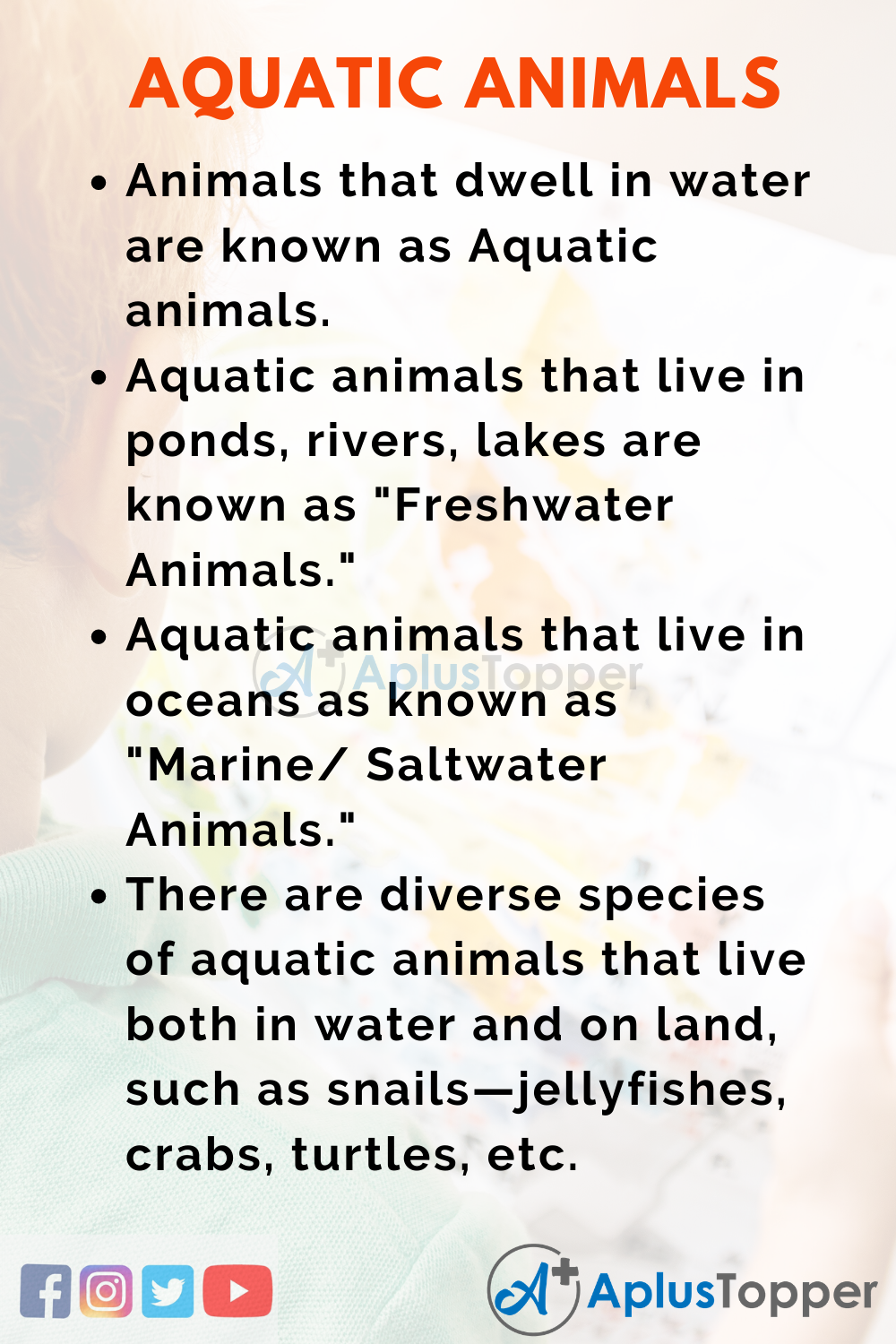10 Lines on Aquatic Animals: Did you know that the popular cartoon Sponge Bob Square Pants is an undersea sponge? A sea sponge is one of the aquatic animals, who have a more rounded shape.
Aquatic animals are those animals that live underwater. There are a vast variety of aquatic creatures with unique characteristics. They live within saltwater liken the ocean, or in freshwaters like the rivers, lakes, and ponds.
Aquatic animals include groups of animals that live underwater, and every creature are of great importance. Among all of them, the vastest and the still mysterious living zone is aquatic life.
We have provided ten lines on Aquatic Animals in English, to aid you in paragraph writings and essays on this topic as well to assist you during competitive exams and G.K. quizzes.
You can read more 10 Lines about articles, events, people, sports, technology many more.
Set 1 – 10 Lines on Aquatic Animals for Kids
Set 1 is helpful for students of Classes 1, 2, 3, 4 and 5.
- Animals that dwell in water are known as Aquatic animals.
- Aquatic animals that live in ponds, rivers, lakes are known as “Freshwater Animals.”
- Aquatic animals that live in oceans as known as “Marine/ Saltwater Animals.”
- There are diverse species of aquatic animals that live both in water and on land, such as snails—jellyfishes, crabs, turtles, etc.
- There are over 230,000 species of Aquatic animals known to man.
- Some aquatic animals breathe oxygen through their gills, while some aquatic animals breathe through their lungs.
- Coastal areas are mainly dependent on aquatic animals as their staple food and for livelihood.
- The regular production and consumption of aquatic animals have led to many endangered species.
- Many industries and companies dump their wastes, chemicals, and experimental products inside water and pollute them.
- Humanity’s Mankind’s increasing pollution has mostly effected all the aquatic lives and has brought them to the verge of extinction.

Set 2 – 10 Lines on Aquatic Animals for School Students
Set 2 is helpful for students of Classes 6, 7 and 8.
- Aquatic animals are those that live in water and perform their life functions underwater.
- Aquatic animals have a different respiratory system that helps them breathe inside water.
- Research and reports have stated the existence of a vast diversity of aquatic animals than those animals on land.
- Many aquatic animals require oxygen for breathing and are known as the ‘Air Breathing Aquatic Animal’.
- Oil spills that occur on the oceans form a layer on the surface of the water and prevent the diffusion of oxygen to the aquatic life.
- Aquatic lifeforms like crabs, fishes, are the source of food, income, and livelihood for people living near the Coastal areas.
- Water pollution has created a barrier for aquatic animals to survive in their zone, and the dumping of plastics have damaged, injured, and killed many aquatic lifeforms.
- The National Aquatic animal of our country is the Ganges River Dolphin present in the Ganges-Brahmaputra area.
- The ‘Mugger Crocodile’ is one of the most common species found on the Indian subcontinent.
- Rivers Ganga and Brahmaputra home India endangered species The ‘Ganges Shark.’
Set 3 – 10 Lines on Aquatic Animals for Higher Class Students
Set 3 is helpful for students of Classes 9, 10, 11, 12 and Competitive Exams.
- Aquatic animals consist of mammals like whales, mollusks such as sea snails, cnidarians, also known as jellyfish, and crustaceans like crabs.
- Aquatic animals are found either in saltwater like the ocean, or in freshwater like the rivers, lakes, and ponds.
- The practice of farming of algae, fishes, crustaceans, and other aquatic organisms for commercial activities and consumption is known as “Aquaculture.”
- Aquaculture provides almost 50 per cent of the farming and production of aquatic animals for consumption and 90 per cent of the farming occurs in the “Asia-Pacific Region”.
- The constant rise in the need for consumption and production of aquatic animals for trade have made them prone to extinction and has led to severe challenges .
- The high chemical content from industries, manufacturing companies, and oil refineries highly pollute and kill the aquatic lifeforms.
- Global warming is another primary reason as it heats the oceans and other water bodies and affects the optimal environments of shellfishes, fishes, crustaceans, and other marine life forms.
- The MPAs or the Marine Protected Areas are signed into law to protect and preserve the endangered and aquatic life forms in the year 1999.
- The Government of India has imposed The Maritime Zones of India Act 1976, to protect the Marine environment and guard its species.
- Another Act called The Coast Guard Act 1978, states the function of the Indian coast guard is to maintain the control of marine pollution and the protection of the marine environment.

FAQ’s on 10 Lines on Aquatic Animals
Question 1.
What are the Aquatic Animals?
Answer:
Aquatic animals are those animals that live underwater and are a wide variety with unique characteristics.
Question 2.
State a few Aquatic Animals known to man.
Answer:
There are diverse species of Aquatic animals such as Electric eel, Turtles, Jellyfish, Blue whales, Dolphins, Seahorses, Great white shark, Oysters, etc.
Question 3.
How has man affected the Aquatic animals?
Answer:
The high chemical content from industries, manufacturing companies, and oil refineries highly pollute, and the dumping of plastics have damaged, injured, and killed many aquatic lifeforms.
Question 4.
What are the Acts undertaken by the Indian Government?
Answer:
The Maritime Zones of India Act 1976 and The Coast Guard Act 1978 are the two Acts undertaken by the Indian Government.
